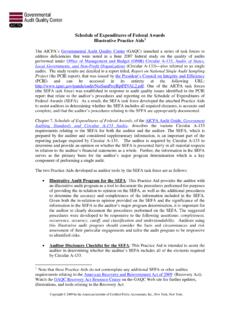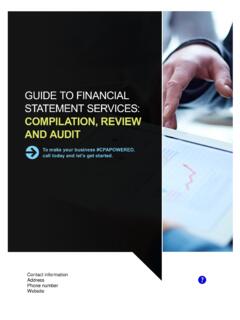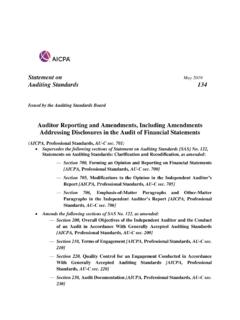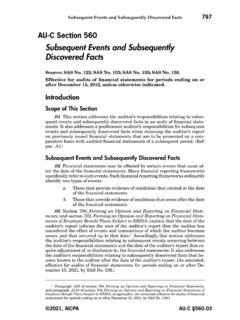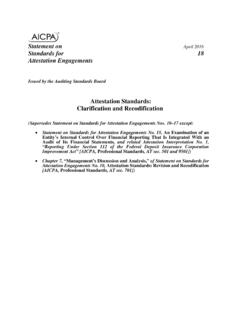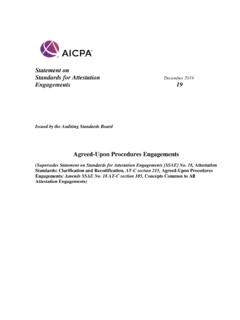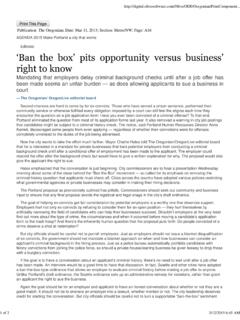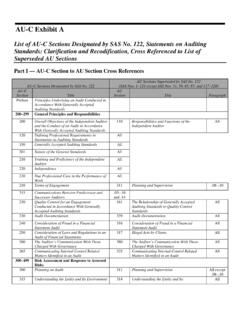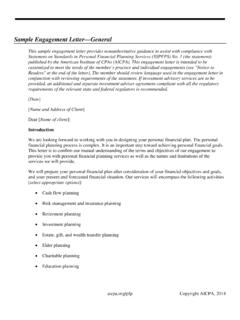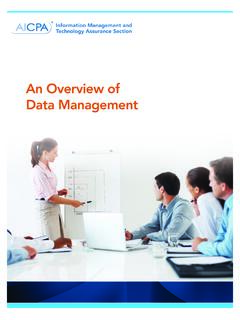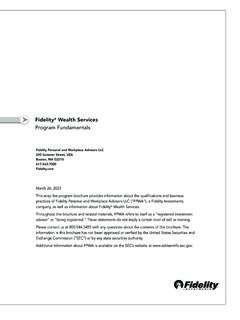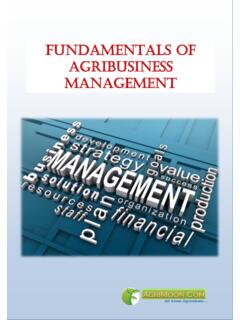Transcription of Single Audit Fundamental Series Part 2: Major Program ...
1 Single Audit fundamentals Part 2: Major Program DeterminationAugust 26, 2020 Governmental Audit Quality CenterEarning CPED isable allpop-up blockersDo not enlarge any windows as they can block you from seeing CPE markersAny answer counts towards CPE creditEarn credit by responding to 75% of pop-upsClick the CPE buttonat the end of this webcast to claim your CPE certificateIf you viewed this webcast as a group, fill out the Group Viewing Form located in the same windowA post event e-mail with CPE information will be sent to you2 Per NASBA.
2 You cannotearn CPE credit by watching the archive of this Helpful HintsAdjust your volume Be sure your computer s sound is turned on. Click this button. Slide the control up or down to fit your your questions Feel free to submit content related questions to the speaker by clicking this button. Someone is available to assist with your technology and CPE related questions, as well. Download your materials Access today s slides and learning materials by clicking this download button at any time during this presentation. If you need help accessing these materials, send a message through the Q&A Closed Captioning Enable Closed Captioning by clicking the CC box found at the bottom of your screen.
3 If you are watching a rebroadcast, the CC button is located within the Media s Sneeringer,CPA,Partner,RSMFlo Ostrum, CPA, Partner,Grant Thornton4 Single Audit fundamentals A Four Part SeriesPart 1, What is a Single Audit ? A Basic Background and OverviewPart 2, Major Program DeterminationPart 3, Understanding and Testing Compliance Requirements and Internal Control over CompliancePart 4, Overview of Sampling and Single Audit Reporting5 Part 2 -what we will cover today6 Considerations prior to Major Program determinationApplying the risk-based approach for determining Major programs under the Uniform Administrative Requirements, Cost Principles, and Audit Requirements for Federal Awards at 2 CFR 200 (UG or Uniform Guidance)
4 Communications with cognizant or oversight agency for auditTerminology and abbreviations7 CFDAC atalog of Federal Domestic Assistance (now called Assistance Listings)OMBO ffice of Management and BudgetFACF ederal Audit ClearinghousePTEPass-Through EntityGAAPG enerally Accepted Accounting PrinciplesR&DResearch & DevelopmentGAS-SA GuideAICPA Audit Guide, Government Auditing Standards and Single AuditsSEFAS chedule of Expenditures of Federal AwardsNIHN ational Institutes of HealthSFAS tudent Financial AssistanceNSFN ational Science FoundationUGUniform GuidanceConsiderations prior to Major Program determination8 Planning begins the UG requirementsEstablishing an understanding with the auditeeAdditional requirements of the Single Audit Act documentation (access)
5 Follow-up on prior year findingsFinancial statement Audit considerationsPlanning also the entity to be auditedDetermining the Audit periodTiming of Audit completionObtaining the SEFAR elevant guidanceSubpart F ( ) of the UGOMB Compliance Supplement Issued annually use the APPLICABLE year s Compliance SupplementAICPA GAS-SA Guide11 SEFA: The footpath to Single Audit performance12 SEFA serves as the foundation for Major Program determination See Part 1 for required SEFA elements and disclosures) SEFA accuracy and completeness are critical to the auditor getting it rightInternal control over compliance Auditor assesses the auditee s controls over the accuracy and completeness of the Program information and expenditure amounts reported on the SEFA, including controls over the accuracy of the CFDA numbersCompliance Audit procedures should be performed to obtain sufficient appropriate Audit evidence supporting the accuracy and completeness of the SEFA.
6 Including the identification of federal programs in the scheduleA warning about noncash awardsLoans and loan guarantees, insurance, endowment funds, free rent, food commodities , donated property, donated surplus propertyReported on face of SEFAIt is important to identify noncash awards as they impact Major Program determination13 Looking at low-risk auditee criteria14 Must meet all of the following for each of the two preceding years: Annual Single audits, including timely filing with FAC Unmodified opinion(s) on financial statements in accordance with GAAP or basis of accounting required by state law Unmodified in-relation-to opinion on the SEFA No material weaknesses in internal control over financial reporting at low-risk auditee criteria15 Must meet all of the following for each of the two preceding years.
7 No findings in type A programs in preceding 2 years material weaknesses in internal control over compliance modified opinion on a Major Program known or likely questioned costs > 5% of expenditures for a type A programNo auditor reporting of going concern of basis of accounting on low-risk auditee determination16If state law permitsbut does not requirean auditee to prepare financial statements in accordance with a basis that is not GAAP ( , cash, regulatory), auditee cannotbe considered low-risk auditee If the non-GAAP basis of accounting is requiredby state law, auditee canbe considered low-risk auditee If auditee voluntarily preparesfinancial statements on a non-GAAP basis of accounting ( , cash or modified cash), auditee cannotbe considered low-risk auditeeApplying the risk-based approach for determining Major programs17 Major Program determination and risk assessmentRisk-based approach to Major Program determinationFour-step approach considers.
8 Current and prior audits Federal agency and/or PTE oversight Program risk18 Major Program determination and risk assessment19 Four-step approachIdentify "type A" programsIdentify low-risk "type A" programsIdentify high-risk "type B" programsDetermine Major programs to auditStep 1 Step 2 Step 3 Step 4 Step 1: Identify type A programs 1stidentify federal programsAll federal awards to a non-federal entity assigned the same Assistance listing number (formerly known as CFDA number)If no Assistance listing number, all federal awards from the same federal agency made for the same purposeClusters 20 1: Identify type A programs What is a cluster?
9 "..a grouping of closely related programs that share common compliance requirements."What kinds of clusters are there? R&D SFA Other clusters defined by OMB in the Compliance Supplement or as designated by a state for federal awards the state provides to its subrecipients that meet the definition of a clusterA cluster of programs must be considered as one Program for determining Major programs21 1: Identify type A programs 22 Part 5 of the Compliance Supplement lists each cluster and specific, unique requirements for eachR&D is the only cluster where specific CFDA numbers are not identified in Part 5 For R&D, auditees look to the definition of R&D and apply judgment to determine inclusion in the cluster 23 Total federal awards expendedType A/B threshold $750,000 and $25 million$750,000 >$25 million but $100 milliontotal federal awards expended times.
10 03>$100 million but $ 1 billion$3 million>$1 billion but $10 billiontotal federal awards expended times .003>$10 billion but $20 billion$30 million>$20 billiontotal federal awards expended times .0015 Step 1: Identify type A programsExample:type A threshold = $750,000 City of Dogwood federal programs: Program 1 -$795,000 type AProgram 2 -$751,000 type AProgram 3 1,785,000 type AProgram 4 -$250,000 type BProgram 5 -$10,000 type BProgram 6 -$749,985 type B24 Programs not labeled as type A are deemed to be type B programsImpact of Large Loan and Loan Guarantees on type A/B ThresholdThe inclusion of large loan and loan guarantees should not result in the exclusion of other programs as type A programs For purposes of type A/B threshold calculation.
